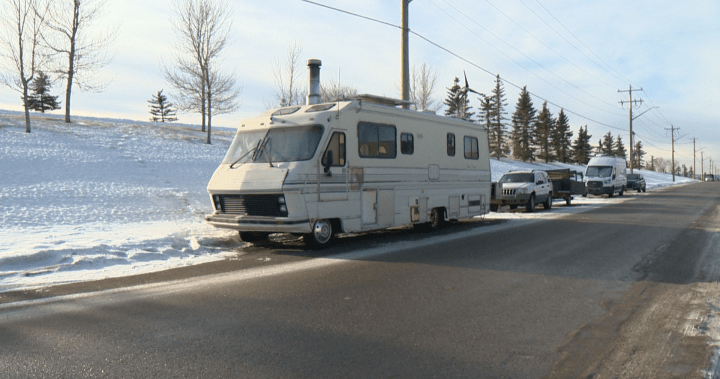The Plight of Victor LaRock and the Growing Visibility of RV Living in Calgary
Victor LaRock, a long-term resident of his RV on Moraine Road in northeast Calgary, found himself unexpectedly displaced in early December 2024. Along with his neighbors, he was forced to relocate after the City of Calgary erected no parking signs, effectively evicting them from their established community. This action, while justified by the city as a response to complaints and necessary infrastructure work, highlights the increasing tensions surrounding RV living within Calgary’s urban landscape. LaRock’s story underscores the complex interplay of housing affordability, municipal regulations, and the perception of RV communities within the city. It also raises questions about the adequacy of support systems for individuals living on fixed incomes and the choices they make to maintain a roof over their heads.
LaRock’s primary concern stems from the seemingly selective enforcement of parking regulations. While he and his seven neighbors were compelled to leave Moraine Road, he points to other locations in the city where larger groups of RVs remain undisturbed. This perceived inconsistency fuels his suspicion that other factors may be at play beyond the official explanation provided by the city. The official statement cited 70 complaints from local businesses and residents, along with the need for traffic control modifications and unspecified maintenance. However, LaRock contests this narrative, claiming that nearby businesses appreciated the constant presence provided by the RV community, which they saw as a deterrent to crime. He also disputes the city’s claims about safety concerns, citing a decade-long residency without any significant traffic incidents.
LaRock’s situation reveals the economic realities driving his choice to live in an RV. He relies on an $800 monthly Canadian Pension Plan disability benefit, a sum that severely limits his housing options in a city with a high cost of living. He maintains that RV living is not his preferred choice, but a necessity dictated by his financial constraints. He expresses a strong desire for traditional housing – an apartment or a house – but acknowledges the financial impossibility of securing such accommodation. His story echoes a broader societal issue: the struggle of low-income individuals to find affordable housing in an increasingly expensive market. LaRock’s case exemplifies how limited resources can force individuals into alternative living arrangements that may fall outside conventional societal norms and become subject to municipal scrutiny.
The City of Calgary’s actions raise questions about the balance between enforcing regulations and addressing the needs of vulnerable populations. While the city has a legitimate interest in managing public spaces and responding to resident concerns, the displacement of individuals like LaRock highlights the potential for such actions to exacerbate existing social and economic challenges. The lack of affordable housing options in Calgary puts those living on fixed incomes in a precarious position, leaving them with few alternatives and susceptible to displacement. The city’s response, while seemingly justified by bureaucratic procedure, potentially overlooks the human cost of these decisions. The sudden eviction of a community, especially one composed of individuals with limited resources, can disrupt established support networks and further marginalize those already struggling.
The incident involving LaRock and his neighbors exposes a broader trend within urban centers: the increasing visibility of RV living and the challenges it presents for municipal governments. As housing costs continue to rise, more individuals are turning to alternative living arrangements, including RVs, as a means of affordability and flexibility. This phenomenon, while offering a solution for some, also creates new challenges related to zoning regulations, infrastructure capacity, and the integration of these communities within the existing urban fabric. Cities grapple with balancing the needs of all residents, ensuring public safety and maintaining existing infrastructure while accommodating those seeking alternative housing solutions. The tension between regulation and accommodation underscores the need for proactive city planning and the development of strategies to address the root causes of the housing affordability crisis.
The story of Victor LaRock is a microcosm of larger societal issues related to housing affordability, social support systems, and the evolving definition of "home" in a rapidly changing urban environment. It serves as a reminder that behind bureaucratic decisions and municipal regulations lie human stories with real-world consequences. As cities grapple with the increasing prevalence of alternative living arrangements, it is crucial to consider the human impact of policies and strive for solutions that address both the needs of the city and the well-being of its most vulnerable residents. The ongoing dialogue surrounding RV living in Calgary necessitates a nuanced approach that considers the diverse circumstances of those choosing this lifestyle and works towards creating a more inclusive and equitable city for all.

